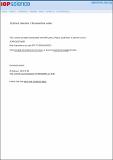(In)direct detection of boosted dark matter
Author(s)
Agashe, Kaustubh; Cui, Yanou; Necib, Lina; Thaler, Jesse
DownloadThaler_(In)direct detection.pdf (1.801Mb)
PUBLISHER_CC
Publisher with Creative Commons License
Creative Commons Attribution
Terms of use
Metadata
Show full item recordAbstract
We initiate the study of novel thermal dark matter (DM) scenarios where present-day annihilation of DM in the galactic center produces boosted stable particles in the dark sector. These stable particles are typically a subdominant DM component, but because they are produced with a large Lorentz boost in this process, they can be detected in large volume terrestrial experiments via neutral-current-like interactions with electrons or nuclei. This novel DM signal thus combines the production mechanism associated with indirect detection experiments (i.e. galactic DM annihilation) with the detection mechanism associated with direct detection experiments (i.e. DM scattering off terrestrial targets). Such processes are generically present in multi-component DM scenarios or those with non-minimal DM stabilization symmetries. As a proof of concept, we present a model of two-component thermal relic DM, where the dominant heavy DM species has no tree-level interactions with the standard model and thus largely evades direct and indirect DM bounds. Instead, its thermal relic abundance is set by annihilation into a subdominant lighter DM species, and the latter can be detected in the boosted channel via the same annihilation process occurring today. Especially for dark sector masses in the 10 MeV–10 GeV range, the most promising signals are electron scattering events pointing toward the galactic center. These can be detected in experiments designed for neutrino physics or proton decay, in particular Super-K and its upgrade Hyper-K, as well as the PINGU/MICA extensions of IceCube. This boosted DM phenomenon highlights the distinctive signatures possible from non-minimal dark sectors.
Date issued
2014-10Department
Massachusetts Institute of Technology. Center for Theoretical Physics; Massachusetts Institute of Technology. Department of PhysicsJournal
Journal of Cosmology and Astroparticle Physics
Publisher
IOP Publishing
Citation
Agashe, Kaustubh, Yanou Cui, Lina Necib, and Jesse Thaler. “(In)direct Detection of Boosted Dark Matter.” Journal of Cosmology and Astroparticle Physics 2014, no. 10 (October 1, 2014): 062–062.
Version: Final published version
ISSN
1475-7516
1475-7508
